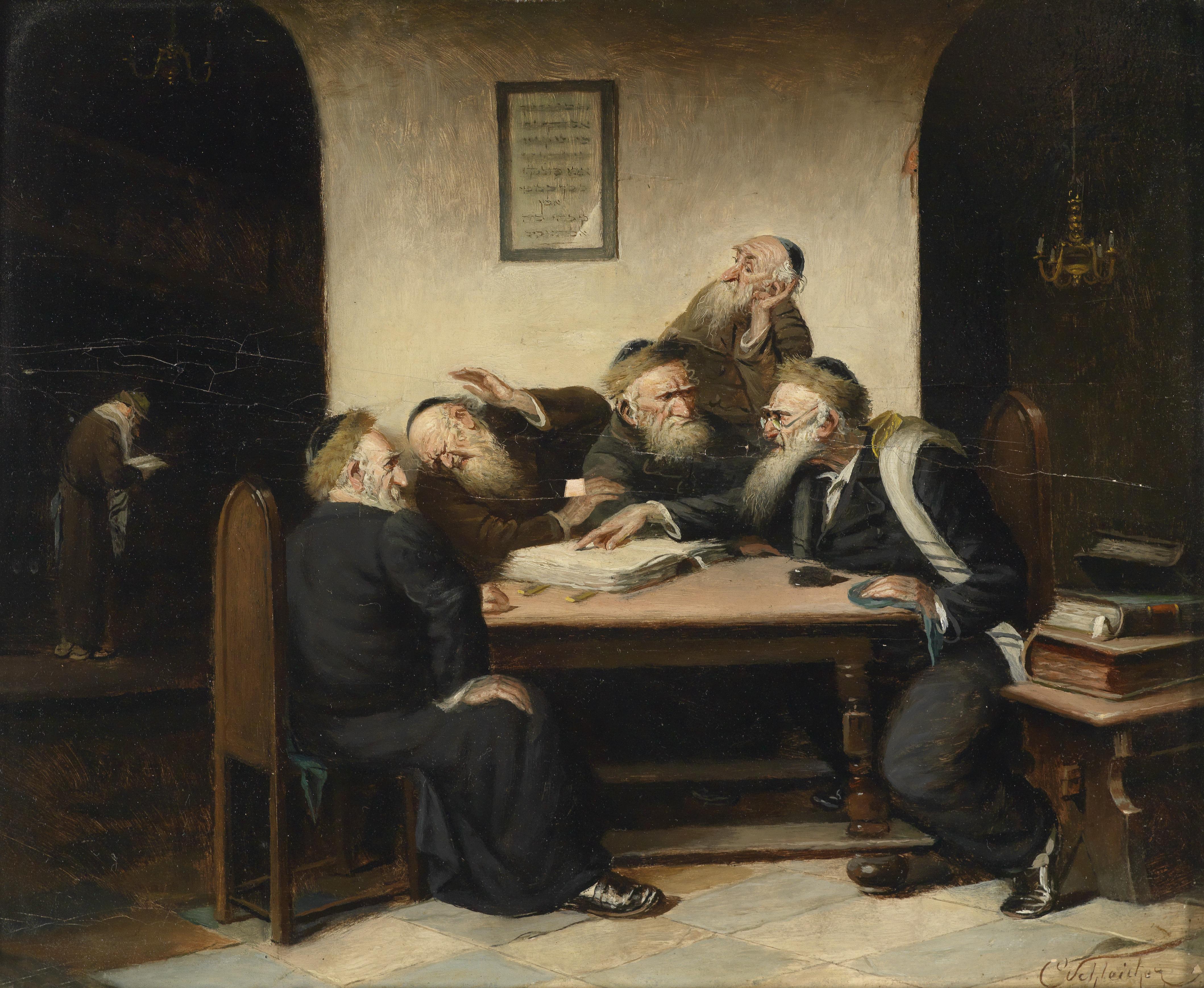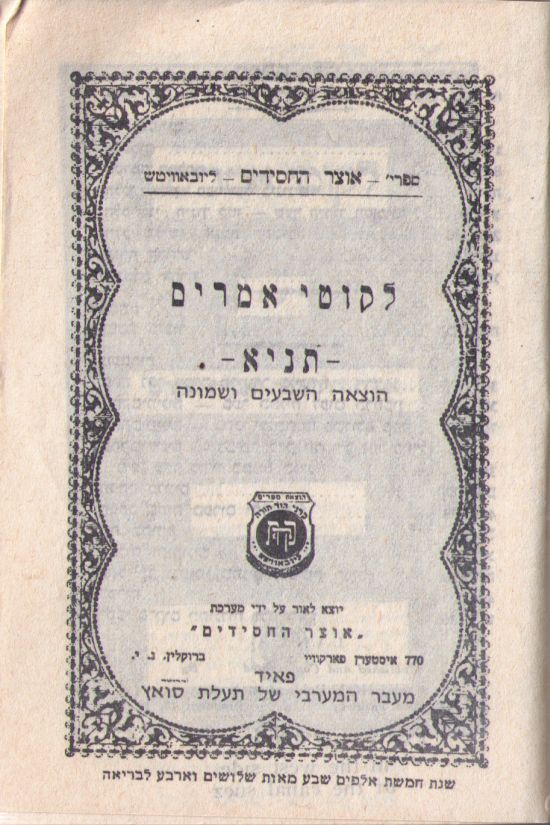|
Chayenu
Chayenu (Hebrew: חַיֵּינוּ ) is a weekly subscription-based publication dedicated to facilitating daily Torah study through established learning cycles founded in 2009 in Brooklyn, New York, specifically targeting individuals engaged in the study of '' Chitas'', an acronym for Chumash, Tehillim, and Tanya. Chayenu is published by the nonprofit company Chayenu, Inc. History The emphasis on daily Torah study, particularly the study of Chitas, was initiated by Chabad's Frierdiker Rebbe, Rabbi Yosef Yitzchak Schneersohn. In the 1960s, the Lubavitcher Rebbe, Rabbi Menachem Mendel Schneersohn called for a widespread campaign to encourage Jews in and out of the Chabad-Lubavich movement to engage in daily study of Chitas. on Shabbat in the year 1967 (5727), the Lubavitcher Rebbe emphasized the importance of Chitas as well as introducing study of Mishneh Torah, a work created by Maimonides. In 2009 Chayenu was established by Mendel Goldman and Louis Perlman, who aimed ... [...More Info...] [...Related Items...] OR: [Wikipedia] [Google] [Baidu] |
Torah Study
Torah study is the study of the Torah, Hebrew Bible, Talmud, responsa, rabbinic literature, and similar works, all of which are Judaism's Sifrei kodesh, religious texts. According to Rabbinic Judaism, the study is done for the purpose of the ''mitzvah'' ("commandment") of Torah study itself. This practice is present to an extent in all religious branches of Judaism, and is considered of paramount importance among religious Jews. Torah study has evolved over the generations, as lifestyles changed and also as new texts were written. Traditional view In rabbinic literature, a heavy emphasis is placed on Torah study for Jews, Jewish males, with women being exempt. This literature teaches an eagerness for such study and a thirst for knowledge that expands beyond the text of the Tanakh to the entire Oral Torah. Some examples of traditional religious teachings: * The study of Torah is "equal to all" of the ''Mitzvah, mitzvot'' of Honour thy father and thy mother, honouring one's pare ... [...More Info...] [...Related Items...] OR: [Wikipedia] [Google] [Baidu] |
Tanya (Judaism)
The ''Tanya'' () is an early work of Hasidic philosophy, by Rabbi Shneur Zalman of Liadi, the founder of Chabad Hasidism, first published in 1796. Its formal title is ''Likkutei Amarim'' (, Hebrew, "collection of statements") but is more commonly known by its first word (''tanya''), which in Aramaic means "it has been taught". Zalman is referring to a baraita in "Niddah" chapter 3 in the word’s first usage. The ''Tanya'' is composed of five sections that define Hasidic mystical psychology and theology as a handbook for daily spiritual life in Jewish observance. The ''Tanya'' is the main work of Chabad philosophy and the Chabad approach to Hasidic mysticism, as it defines its general interpretation and method. The subsequent extensive library of the Chabad school, authored by successive leaders, builds upon the approach of the ''Tanya''. Chabad differed from mainstream Hasidism by its philosophical investigation and intellectual analysis of Hasidic Torah exegesis. Thi ... [...More Info...] [...Related Items...] OR: [Wikipedia] [Google] [Baidu] |
Chitas
''Chitas'' or ''Chitat'' (, , ) is a Hebrew acronym for ''Chumash'' (the five books of Moses), ''Tehillim'' (Psalms The Book of Psalms ( , ; ; ; ; , in Islam also called Zabur, ), also known as the Psalter, is the first book of the third section of the Tanakh (Hebrew Bible) called ('Writings'), and a book of the Old Testament. The book is an anthology of B ...), and ''Tanya'' (a seminal work of Hasidic philosophy by Rabbi Schneur Zalman of Liadi). These are considered basic Jewish texts according to the Chabad Jewish community, a Hasidic group. It is their custom to study these works according to a yearly cycle, which is known colloquially as "doing ''ChiTaS''." See also * * Chayenu * Devar Malchot References {{Chabad Chabad-Lubavitch texts Yosef Yitzchak Schneersohn Chabad-Lubavitch (Hasidic dynasty) ... [...More Info...] [...Related Items...] OR: [Wikipedia] [Google] [Baidu] |
Vayeira
Vayeira, Vayera, or (—Hebrew for "and He appeared," the first word in the parashah) is the fourth weekly Torah portion (, ''parashah'') in the annual Jewish cycle of Torah reading. It constitutes Genesis 18:1–22:24. The parashah tells the stories of Abraham's three visitors, Abraham's bargaining with God over Sodom and Gomorrah, Lot's two visitors, Lot's bargaining with the Sodomites, Lot's flight, the destruction of Sodom and Gomorrah, how Lot's daughters became pregnant by their father, how Abraham once again passed off his wife Sarah as his sister, the birth of Isaac, the expulsion of Hagar, disputes over wells, and the binding of Isaac (, the ''Akedah''). The parashah has the most words (but not the most letters or verses) of any of the weekly Torah portions in the Book of Genesis, and its word-count is second only to Parashat Naso in the entire Torah. It is made up of 7,862 Hebrew letters, 2,085 Hebrew words, 147 verses, and 252 lines in a Torah Scroll (''Sefer ... [...More Info...] [...Related Items...] OR: [Wikipedia] [Google] [Baidu] |
Maimonides
Moses ben Maimon (1138–1204), commonly known as Maimonides (, ) and also referred to by the Hebrew acronym Rambam (), was a Sephardic rabbi and Jewish philosophy, philosopher who became one of the most prolific and influential Torah scholars of the Middle Ages. In his time, he was also a preeminent astronomer and physician, serving as the personal physician of Saladin. He was born on Passover eve 1138 or 1135, and lived in Córdoba, Spain, Córdoba in al-Andalus (now in Spain) within the Almoravid dynasty, Almoravid Empire until his family was expelled for refusing to convert to Islam. Later, he lived in Morocco and Egypt and worked as a rabbi, physician and philosopher. During his lifetime, most Jews greeted Maimonides' writings on Halakha, Jewish law and Jewish ethics, ethics with acclaim and gratitude, even as far away as Iraq and Yemen. Yet, while Maimonides rose to become the revered head of the History of the Jews in Egypt, Jewish community in Egypt, his writings also ... [...More Info...] [...Related Items...] OR: [Wikipedia] [Google] [Baidu] |
Chabad Mitzvah Campaigns
Chabad mitzvah campaigns, or ''Mivtzo'im'' () refer to several campaigns launched by the Lubavitcher Rebbe, Menachem Mendel Schneerson. From 1967 to 1976, Schneerson said all Jews should observe ten basic "beginner's mitzvot" (commandments) . In the years that followed there were campaigns for additional mitzvot as well. The ten campaigns *Tefillin: Men (age 13 and up) are encouraged to wear the tefillin every morning excluding Shabbat (the sabbath, from late Friday afternoon to early Saturday evening) and festivals. Started in 1967. *Shabbat Candles: Women and girls (age 3 and up) are encouraged to light candles 18 minutes before sunset, on Friday afternoon to start the sabbath, and also to start festivals. *Mezuzah: Says that every Jewish home should have a mezuzah on its doorposts. Started in the year 1974. *Torah Study: Says to study a portion of Torah daily. *Tzedakah (Charity): Says to give charity daily. * Holy Books: Encouraged furnishing homes with as many holy books ... [...More Info...] [...Related Items...] OR: [Wikipedia] [Google] [Baidu] |
Shabbat
Shabbat (, , or ; , , ) or the Sabbath (), also called Shabbos (, ) by Ashkenazi Hebrew, Ashkenazim, is Judaism's day of rest on the seventh day of the seven-day week, week—i.e., Friday prayer, Friday–Saturday. On this day, religious Jews remember the biblical stories describing the Genesis creation narrative, creation of the heaven and earth in six days and the redemption from slavery and the Exodus from Egypt. Since the Hebrew calendar, Jewish religious calendar counts days from sunset to sunset, Shabbat begins in the evening of what on the civil calendar is Friday. Shabbat observance entails refraining from 39 Melachot, work activities, often with shomer Shabbat, great rigor, and engaging in restful activities to honor the day. Judaism's traditional position is that the unbroken seventh-day Shabbat originated among the Jewish people, as their first and most sacred institution. Variations upon Shabbat are widespread in Judaism and, with adaptations, throughout the Abraham ... [...More Info...] [...Related Items...] OR: [Wikipedia] [Google] [Baidu] |
Mishneh Torah
The ''Mishneh Torah'' (), also known as ''Sefer Yad ha-Hazaka'' (), is a code of Rabbinic Jewish religious law (''halakha'') authored by Maimonides (Rabbi Moshe ben Maimon/Rambam). The ''Mishneh Torah'' was compiled between 1170 and 1180 CE (4930 and 4940 AM), while Maimonides was living in Egypt, and is regarded as Maimonides' '' magnum opus''. Accordingly, later sources simply refer to the work as "''Maimon''", "''Maimonides''", or "''RaMBaM''", although Maimonides composed other works. ''Mishneh Torah'' consists of fourteen books, subdivided into sections, chapters, and paragraphs. It is the only medieval-era work that details all of Jewish observance, including those laws that are only applicable when the Temple in Jerusalem is in existence, and remains an important work in Judaism. Its title is an appellation originally used for the Biblical book of Deuteronomy, and its moniker, "Book of the Strong Hand", derives from its subdivision into fourteen books: the numerical v ... [...More Info...] [...Related Items...] OR: [Wikipedia] [Google] [Baidu] |
Kehot
Kehot Publication Society is the publishing division of the Chabad-Lubavitch movement. History Kehot was established in 1941 by the sixth Rebbe of Chabad-Lubavitch, Rabbi Yosef Yitzchak Schneersohn. In 1942, Rabbi Yosef Yitzchak appointed his son-in-law, Rabbi Menachem Mendel Schneerson (who became the seventh Rebbe in 1951) as director and editor-in-chief. Prior to the establishment of Kehot, printed editions of Chabad texts were limited. Since its founding, Kehot published many volumes of both Hasidic texts and general Jewish literature, growing significantly as an established publisher of Jewish books published in several languages. Rabbi Menachem Mendel served as editor for many of the early Kehot publications. In a 1946, he wrote of his editorial work for Jewish holiday literature published in French and in English. He edited both Jewish educational literature for children as well as volumes of Hasidic discourses.Igrot Kodesh vol. 2, page 90 Name The name ''Kehot'' (קה" ... [...More Info...] [...Related Items...] OR: [Wikipedia] [Google] [Baidu] |
Igrot Kodesh
''Igrot Kodesh'' (literally "Holy Epistles" but more commonly known as "Letters of the Rebbe") is a collection of correspondence and responses of the seventh Rebbe of Chabad-Lubavitch, Menachem Mendel Schneerson. It is modeled after ''Igrot Kodesh Maharayatz'' which are the letters of the sixth Rebbe of Lubavitch, Yosef Yitzchok Schneersohn. The topics considered in these letters include many realms of discussion, and numerous disciplines of human pursuit. Its purview encompassing philosophy (be it Talmudic, Halachic, Hasidic, mystical Mysticism is popularly known as becoming one with God or the Absolute, but may refer to any kind of ecstasy or altered state of consciousness which is given a religious or spiritual meaning. It may also refer to the attainment of insight ... or other), scientific matters, global events, counsel in private issues, schooling, and social/communal proceedings. There is a practice among many Jews, particularly within members of Chabad-Lubav ... [...More Info...] [...Related Items...] OR: [Wikipedia] [Google] [Baidu] |
Frierdiker Rebbe
Yosef Yitzchak (Joseph Isaac) Schneersohn (; 21 June 1880 – 28 January 1950) was an Orthodox rabbi and the sixth Rebbe (spiritual leader) of the Chabad Lubavitch Hasidic movement. He is also known as the Frierdiker Rebbe (Yiddish for "Previous Rebbe"), the ''Rebbe RaYYaTz'', or the ''Rebbe Rayatz'' (an acronym for Rabbi Yosef Yitzchak). After many years of fighting to keep Orthodox Judaism alive from within the Soviet Union, he was forced to leave; he continued to conduct the struggle from Latvia, and then Poland, and eventually the United States, where he spent the last ten years of his life. Early life Yosef Yitzchak Schneersohn was born in Lyubavichi, Mogilev Governorate, Russian Empire (present-day Smolensk Oblast, Russia), the only son of Sholom Dovber Schneersohn (the ''Rebbe Rashab''), the fifth Rebbe of Chabad. He was appointed as his father's personal secretary at the age of 15; in that year, he represented his father in the conference of communal leaders in Ko ... [...More Info...] [...Related Items...] OR: [Wikipedia] [Google] [Baidu] |






